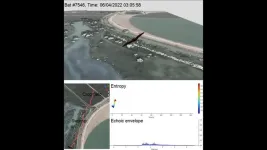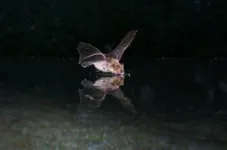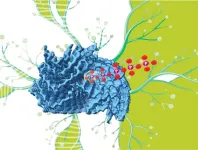(Press-News.org) Echolocating bats have been found to possess an acoustic cognitive map of their home range, enabling them to navigate over kilometer-scale distances using echolocation alone. This finding, recently published in Science, was demonstrated by researchers from the Max Planck Institute of Animal Behavior, the Cluster of Excellence Centre for the Advanced Study of Collective Behaviour at the University of Konstanz Germany, Tel Aviv University, and the Hebrew University of Jerusalem, Israel.
Would you be able to instantly recognize your location and find your way home from any random point within a three-kilometer radius, in complete darkness, with only a flashlight to guide you? Echolocating bats face a similar challenge, with a local and directed beam of sound—their echolocation—to guide their way. Bats have long been known for their use of echolocation to avoid obstacles and orient themselves. However, the research team, led by Aya Goldshtein from Iain Couzin’s group at the Max Planck Institute of Animal Behavior and the Cluster of Excellence Centre for the Advanced Study of Collective Behaviour at the University of Konstanz, has now shown that bats can identify their location even after being displaced and use echolocation to perform map-based navigation over long distances.
Study with 6-gram light bats
To explore this, the team conducted experiments with Kuhl’s pipistrelle (Pipistrellus kuhlii), a bat species weighing only 6 grams, in Israel’s Hula Valley. Over several nights, the researchers tracked 76 bats near their roosts and relocated them to various points within a three-kilometer radius, but still within their home range. Each bat was tagged with an innovative lightweight reverse GPS tracking system called ATLAS, which provided high-resolution, real-time tracking.
Some bats were fitted solely with the ATLAS system, while others were additionally manipulated to assess how their vision, sense of smell, magnetic sense, and echolocation influenced their ability to navigate back to their roosts. Remarkably, even with echolocation alone, 95 percent of the bats returned to their roosts within minutes, demonstrating that bats can conduct kilometer-scale navigation using only this highly directional, and relatively local, mode of sensing. However, it was also shown that, when available, bats improve their navigation using vision. “We were surprised to discover that these bats also use vision,” notes Aya Goldshtein. “That was not what we expected. It was incredible to see that, even with such small eyes, they can rely on vision under these conditions.”
Modulation of each bat’s flight
In addition to the field experiments, the team created a detailed map of the entire valley. “We wanted to visualize what each bat experienced during flight and understand how they used acoustic information to navigate,” explains Xing Chen, from Yossi Yovel’s lab at Tel Aviv University, who developed the valley’s reconstruction.
The model revealed that bats tend to fly near environmental features with higher ‘echoic entropy'—areas that provide richer acoustic information. “During the localization phase, bats conduct a meandering flight that, at a certain point, changes to a directional flight toward their destination, suggesting they already know where they are,” says Goldshtein. “Bats fly near environmental features with more acoustic information and make navigation decisions.” Bats can use this acoustic information to distinguish between environmental features such as a tree and a road, and thus use them as acoustic landmarks.
Bats have an acoustic mental map
The study concludes that Kuhl’s pipistrelles can navigate over several kilometers using echolocation alone. However, when vision is available, they enhance their navigation performance by combining both senses. After being displaced, these small bats first identify their new location and then fly home, using environmental features with distinctive acoustic cues as landmarks. This behavior suggests they possess an acoustic mental map of their home range.
END
Echolocating bats use an acoustic cognitive map for navigation
2024-10-31
ELSE PRESS RELEASES FROM THIS DATE:
Researchers solve medical mystery of neurological symptoms in kids
2024-10-31
Most people who visit a doctor when they feel unwell seek a diagnosis and a treatment plan. But for some 30 million Americans with rare diseases, their symptoms don’t match well-known disease patterns, sending families on diagnostic odysseys that can last years or even lifetimes.
But a cross-disciplinary team of researchers and physicians from Washington University School of Medicine in St. Louis and colleagues from around the world has solved the mystery of a child with a rare genetic illness that did not fit any known disease. The team found a link between the child’s neurological symptoms and a genetic change that affects how proteins ...
Finding a missing piece for neurodegenerative disease research
2024-10-31
Research led by the University of Michigan has provided compelling evidence that could solve a fundamental mystery in the makeup of fibrils that play a role in Alzheimer's, Parkinson's and other neurodegenerative diseases.
"We've seen that patients have these fibril structures in their brains for a long time now," said Ursula Jakob, senior author of the new study. "But the questions are what do these fibrils do? What is their role in disease? And, most importantly, can we do something to get rid of them if they are responsible for these devastating diseases?"
Although the new finding does not explicitly answer those questions, it may provide a missing ...
Journal of the Royal Society of Medicine ranked in global top ten medical journals
2024-10-31
Notes to editors
For further information please contact:
Karen Nower
Media Office, Royal Society of Medicine
M: +44 (0)7587 084402
E: media@rsm.ac.uk
The Journal of the Royal Society of Medicine (JRSM) has been ranked as one of the world’s top ten general medicine journals for the first time.
Being placed tenth out of 329 ‘general and internal medicine’ titles in Clarivate’s 2023 Journal Citation Reports (JCR), this is JRSM’s highest ever ranking to date, having risen yearly ...
A new piece in the grass pea puzzle - updated genome sequence published
2024-10-31
An international research collaboration has completed the most detailed genome assembly to date of grass pea (Lathyrus sativus).
This new chromosome-scale reference genome published in Scientific Data offers new potential to accelerate modern breeding of this underutilised legume for climate-smart agriculture.
Nearly twice the size of the human genome, the sequence was assembled from scratch and improves on an earlier draft assembly of the vigorous grass pea line LS007.
“We ...
“Wearable” devices for cells
2024-10-31
CAMBRDIGE, MA – Wearable devices like smartwatches and fitness trackers interact with parts of our bodies to measure and learn from internal processes, such as our heart rate or sleep stages.
Now, MIT researchers have developed wearable devices that may be able to perform similar functions for individual cells inside the body.
These battery-free, subcellular-sized devices, made of a soft polymer, are designed to gently wrap around different parts of neurons, such as axons and dendrites, without damaging the cells, upon wireless actuation with light. By snugly wrapping neuronal processes, they could be used to measure ...
Cancer management: Stent sensor can warn of blockages in the bile duct
2024-10-31
Images
Stents to treat various blockages in the human body can themselves become blocked, but a new sensor developed at the University of Michigan for stents that are used in the bile duct may one day help doctors detect and treat stent blockages early, helping keep patients healthier.
Bile duct blockages can cause jaundice, liver damage and potentially life-threatening infections. Conditions that cause the bile ducts to narrow and close, including pancreatic and liver ...
Nov. 14 AARP Author Q&A at GSA 2024 in Seattle: Debra Whitman, Global Aging Expert and Author of ‘The Second Fifty: Answers to the 7 Big Questions of Midlife and Beyond’
2024-10-31
Author Q&A: Debra Whitman, Global Aging Expert and Author of “The Second Fifty”
Date: Thursday, November 14
Time: 4:30 to 5:30 p.m. PT
Location: Seattle Convention Center Arch Building Room 305
Registration: GSA 2024 Annual Scientific Meeting media registration is required to attend this event.
During this meet-the-author media roundtable, Debra Whitman, executive vice president and chief public policy officer at AARP, will discuss her new book, “The Second Fifty: Answers to the 7 Big ...
Autistic psychiatrists who don't know they're autistic may fail to spot autism in patients
2024-10-31
Groundbreaking research exploring the experiences of autistic psychiatrists has revealed that psychiatrists who are unaware that they themselves are autistic may fail to recognise the condition in their patients. The study, conducted by researchers from University College Dublin, London South Bank University, Brighton and Sussex Medical School, is the first of its kind to delve into the lives of neurodivergent psychiatrists. It was published today in BJPsych Open.
"Knowing that you are autistic can be positively life-changing," said the study author Dr Mary Doherty, Clinical Associate ...
New findings on animal viruses with potential to infect humans
2024-10-31
COLUMBUS, Ohio – Scientists investigating animal viruses with potential to infect humans have identified a critical protein that could enable spillover of a family of organisms called arteriviruses.
In a new study, researchers identified a protein in mammals that welcomes arteriviruses into host cells to start an infection. The team also found that an existing monoclonal antibody that binds to this protein protects cells from viral infection.
Arteriviruses circulate broadly in many types of mammals around the world that serve as natural hosts – such as ...
Ancient rocks may bring dark matter to light
2024-10-31
The visible universe — all the potatoes, gas giants, steamy romance novels, black holes, questionable tattoos, and overwritten sentences — accounts for only 5 percent of the cosmos.
A Virginia Tech-led team is hunting for the rest of it, not with telescopes or particle colliders, but by scrutinizing billion-year-old rocks for traces of dark matter.
In leading a transdisciplinary team from multiple universities on this unconventional search, physics’ Patrick Huber is also taking an unconventional step: from theoretical work into experimental work.
With support from a $3.5 million Growing Convergence Research ...







